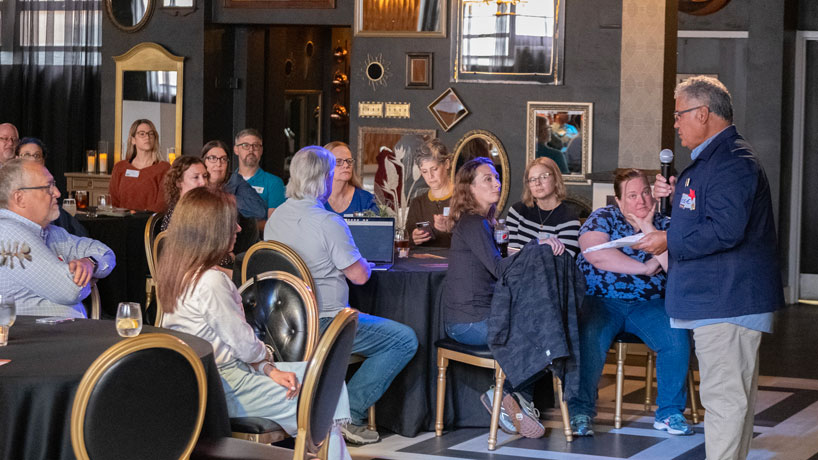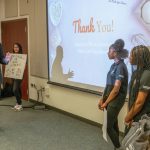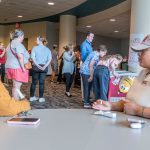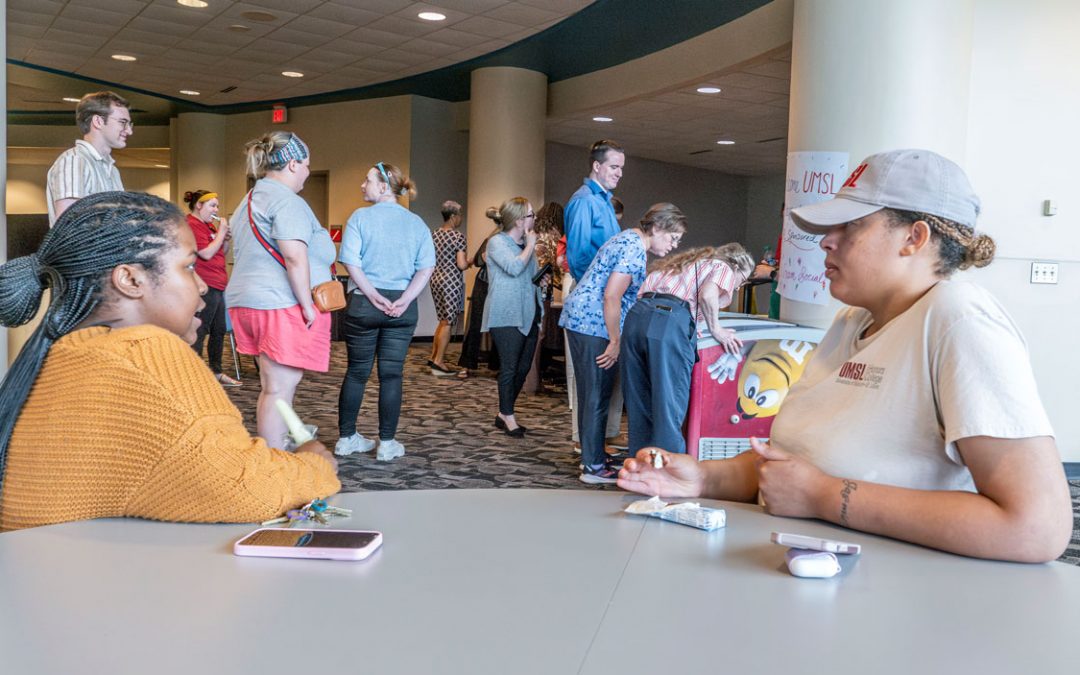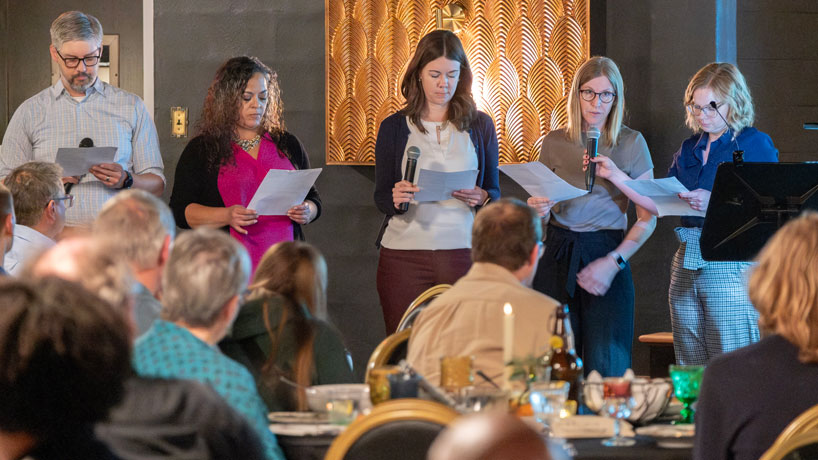
Members of the Missouri Institute of Mental Health’s Mental Health First Aid team present during the culminating event for the fifth Scientist Artist Collaborative on Oct. 26 at The Leona. The theme for the collaborative was “Tell Us Your Story.” MIMH teams shared stories of people they encounter in their work to improve mental health across the state. (Photos by Derik Holtmann
They stood side by side – Rachel Taube, Amy Bartels, Candace Alba-Marshall, Isaac Sandidge and Alissa Naumann – just in front of the stage one evening late last month in the basement banquet space at The Leona in south St. Louis.
Before them sat an audience of their peers from the Missouri Institute of Mental Health at the University of Missouri–St. Louis, eager to hear their story.
“I am a wife and a parent to four wonderful young people. A retired federal law enforcement officer after 27-plus years,” one began.
“I am a high school assistant principal,” another said.
“I am a former teacher,” one more added.
“I am a 44-year-old Latina woman from the east side of Kansas City,” the next person said.
“I am a Mental Health First Aid coordinator and a qualified instructor,” one more voice followed.
So it continued over the next several minutes as they took turns revealing details from individual lives.
The dread and exhaustion one described feeling each day arriving in the parking lot before heading into her toxic work environment.
The pain another experienced after being disowned by his family because they were gay.
The fear another felt while unsure how to help a loved one struggling, reluctant to ask if he was having thoughts of suicide in case it would put the thought in his mind.
Taube, Bartels, Alba-Marshall, Sandidge and Naumann weren’t speaking for themselves but rather revealing information they’d gathered through interviews with people they work with regularly while providing Mental Health First Aid training around the state of Missouri. The narratives woven together helped tell a unified story of the impact the training has helping people recognize and respond to signs and symptoms of mental health and substance use concerns while there’s still time to improve outcomes.
The interviews and presentation were all part of MIMH’s fifth Scientist Artist Collaborative, a professional development program designed to connect MIMH researchers with artists and push them out of their comfort zones to unlock their creativity.
“This is a program that’s very dear to my heart,” said Curators’ Distinguished Professor Robert Paul, who helped create the Scientist Artist Collaborative soon after taking over as MIMH’s director in 2014. “We were really looking for a program that really helped people feel inspired to work more creatively, to think outside the box and really stretch themselves in ways that help with success.”
Outside their comfort zones
MIMH researchers have been prolific, receiving more than $26 million in awards for research and other sponsored activities last fiscal year. They also had over $24 million in expenditures. Their work touches on many different aspects of mental health, including addiction science, precision health, professional training and evaluation.
Playwright José Cruz González speaks to staff members of the Missouri Institute of Mental Health during a kickoff event for the Scientist Artist Collaborative on Oct. 5 at The Leona.
Associate Director Rachel Kryah believes opportunities such as the Scientist Artist Collaborative can help enhance their work. She has coordinated the program since its inception, loosely modeling it after similar programs connecting scientists and artists at the Massachusetts Institute of Technology and the University of California, San Francisco.
Previous iterations have had MIMH researchers working with visual artists, actors and song writers, including most recently soul singer Brian Owens in early 2020, right before the onset of the COVID-19 pandemic.
This year, playwright José Cruz González, an emeritus professor of theatre arts at California State University, Los Angeles, led MIMH through an exercise in storytelling.
He flew to St. Louis for a kickoff luncheon on Oct. 5, during which he posed a series of questions – everything from what part of the country they are from or whether they have siblings or the level of education they have received or their parents received before them. It got them thinking about how all people have stories to share with unique details that have helped shape them.
González then talked to them about conducting an interview and gave them tips for interviewing others before giving them their ultimate assignment – to interview someone they encounter in their work so that they could share their story.
“Most people aren’t ever asked what their story is,” González said. “As a storyteller, people just bloom when somebody asks them, ‘Tell me your story.’”
All the MIMH staff members worked with their teams to conduct the interview and shape the stories they wished to tell. González held weekly check-ins with each team via Zoom to answer questions or help them refine their work.
Human impact
Kryah, part of the evaluation team, knew right away she wanted to share the story of Christa Francis, a young woman who has experienced early psychosis and now works in the early psychosis care center that Kryah helps oversee.
“Every time that Christa shares her story, it just hits me, and I get goosebumps,” Kryah said.
Members of the MIMH staff participate in a warmup activity during a kickoff luncheon for the Scientist Artist Collaborative on Oct. 5 at The Leona in South St. Louis.
Kryah and her teammates interviewed Francis and found a new and engaging way to present her story, telling it in the third person and starting each paragraph with “She’s just a girl.” Kryah credited Rebecca Preston with taking the lead crafting the story and revealing some of the challenges Francis has faced and worked to overcome in her 20s.
Other teams shared their own gripping and inspiring stories during the culminating event on Oct. 26, included that of Rev. Burton Barr Jr., a one-time con-artist turned preacher whose faith helped him overcome addiction, and John Cornelius, who was raised on the Pine Ridge Reservation in South Dakota and now lives in Poplar Bluff, Missouri, where he provides QPR training – question, persuade and refer to help – to help community members recognize and respond to the warning signs of a suicide crisis.
“We got a lot of personal stories, which I think really helps to humanize the work that these folks are doing,” González said. “For me as an artist coming into this and to learn about this organization I knew nothing about until I started talking with these people, I’m going, ‘Wow, really incredible work.’”
A bigger story
Kryah was grateful to see the care that went into each story and the creativity on display.
“When we go into this process with the artists, we are never certain – and I don’t believe that the artist is ever really certain – where we’re going to end up,” Kryah said. “It kind of evolves. All the departments were just really dedicated to the process.”
Based on the feedback Kryah has received, her colleagues also got a lot out of it.
“I’ve participated in several over the last however many years we’ve been doing it,” Taube said. “I think this one stood out to me, both being helpful for the creative process and art disrupting science as it’s supposed to, but it was also really was motivational and nice to reflect on the work that we’re doing and that bigger picture – the purpose and the mission of the things we do.
“Sometimes in the day to day of the work that we do, you forget the real people who are behind the work and the only reason that we’re here. I think it was really nice that it helped us to articulate our story a little bit better.”
Paul hopes his colleagues will take what they learned throughout the exercise and use it in their work.
“Everything that we produce is a written product, and that’s a narrative, and we need to write a narrative that reflects the lives of individuals that we’re working with,” he said. “Our goal is to try to make the world a better place. That’s a big story to tell, but it’s why this group does what they do, and it’s just amazing how successful this group is because of who they are.”

